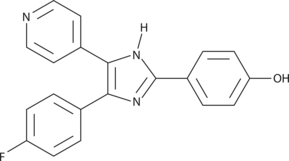Chemicals
Showing 35101–35250 of 41137 results
-
Smoothened (SMO) is a GPCR-like receptor which, with Patched, mediates hedgehog signaling to regulate gene expression through the Gli transcription factors.{21774} SANT 1 is a potent inhibitor of hedgehog signaling that acts by directly antagonizing SMO (IC50 = 20 nM).{21771} It counteracts SMO activation by the SMO agonist SAG but only partially competes with SAG binding to SMO.{21771,24191} SANT 1 targets inactive SMO while it is in the cytoplasm, before it relocates to the primary cilium and is activated.{22122} Through antagonism of SMO, SANT 1 represses Gli-mediated transcription in a variety of cell types.{22122,24193}
Brand:CaymanSKU:-Smoothened (SMO) is a GPCR-like receptor which, with Patched, mediates hedgehog signaling to regulate gene expression through the Gli transcription factors.{21774} SANT 1 is a potent inhibitor of hedgehog signaling that acts by directly antagonizing SMO (IC50 = 20 nM).{21771} It counteracts SMO activation by the SMO agonist SAG but only partially competes with SAG binding to SMO.{21771,24191} SANT 1 targets inactive SMO while it is in the cytoplasm, before it relocates to the primary cilium and is activated.{22122} Through antagonism of SMO, SANT 1 represses Gli-mediated transcription in a variety of cell types.{22122,24193}
Brand:CaymanSKU:-Smoothened (SMO) is a GPCR-like receptor which, with Patched, mediates hedgehog signaling to regulate gene expression through the Gli transcription factors.{21774} SANT 1 is a potent inhibitor of hedgehog signaling that acts by directly antagonizing SMO (IC50 = 20 nM).{21771} It counteracts SMO activation by the SMO agonist SAG but only partially competes with SAG binding to SMO.{21771,24191} SANT 1 targets inactive SMO while it is in the cytoplasm, before it relocates to the primary cilium and is activated.{22122} Through antagonism of SMO, SANT 1 represses Gli-mediated transcription in a variety of cell types.{22122,24193}
Brand:CaymanSKU:-SANT-2 is a Smoothened (Smo) receptor antagonist.{21771,24191} It binds to the Smo receptor (Kd = 12 nM) and inhibits binding of the Smo receptor agonist SAG-1.3 (SAG; Item No. 11914) and antagonist cyclopamine (Item No. 11321) (Kis = 7.8 and 8.4 nM, respectively). SANT-2 inhibits hedgehog signaling induced by an N-terminal fragment of sonic hedgehog (Shh) in an Shh-LIGHT2 cellular assay (IC50 = 30 nM).{21771}
Brand:CaymanSKU:21208 -Out of stock
SANT-2 is a Smoothened (Smo) receptor antagonist.{21771,24191} It binds to the Smo receptor (Kd = 12 nM) and inhibits binding of the Smo receptor agonist SAG-1.3 (SAG; Item No. 11914) and antagonist cyclopamine (Item No. 11321) (Kis = 7.8 and 8.4 nM, respectively). SANT-2 inhibits hedgehog signaling induced by an N-terminal fragment of sonic hedgehog (Shh) in an Shh-LIGHT2 cellular assay (IC50 = 30 nM).{21771}
Brand:CaymanSKU:21208 -Out of stock
SANT-2 is a Smoothened (Smo) receptor antagonist.{21771,24191} It binds to the Smo receptor (Kd = 12 nM) and inhibits binding of the Smo receptor agonist SAG-1.3 (SAG; Item No. 11914) and antagonist cyclopamine (Item No. 11321) (Kis = 7.8 and 8.4 nM, respectively). SANT-2 inhibits hedgehog signaling induced by an N-terminal fragment of sonic hedgehog (Shh) in an Shh-LIGHT2 cellular assay (IC50 = 30 nM).{21771}
Brand:CaymanSKU:21208 -Out of stock
SANT-2 is a Smoothened (Smo) receptor antagonist.{21771,24191} It binds to the Smo receptor (Kd = 12 nM) and inhibits binding of the Smo receptor agonist SAG-1.3 (SAG; Item No. 11914) and antagonist cyclopamine (Item No. 11321) (Kis = 7.8 and 8.4 nM, respectively). SANT-2 inhibits hedgehog signaling induced by an N-terminal fragment of sonic hedgehog (Shh) in an Shh-LIGHT2 cellular assay (IC50 = 30 nM).{21771}
Brand:CaymanSKU:21208 -Out of stock
Santonin is a sesquiterpenoid lactone that has been found in Artemisia.{48410} It has been used as a building block in the synthesis of terpenoids. Santonin is an anthelmintic that induces paralysis of A. lumbricoides.{48411}
Brand:CaymanSKU:27460 - 10 gAvailable on backorder
Santonin is a sesquiterpenoid lactone that has been found in Artemisia.{48410} It has been used as a building block in the synthesis of terpenoids. Santonin is an anthelmintic that induces paralysis of A. lumbricoides.{48411}
Brand:CaymanSKU:27460 - 5 gAvailable on backorder
Sappanone A is a homoisoflavonoid with diverse biological activities that has been isolated from the aerial parts of C. pulcherrima, the heartwood of C. sappan, and the stems of H. campechianum.{41699,41700,41701,41702,41703} In vitro, sappanone A inhibits 76.2, 59.2, 37.4, and 35.4% of FGFR1, KDR, c-Met, and c-Kit kinase activity, respectively, when used at a concentration of 10 μM.{41699} It also inhibits influenza viral neuraminidase (NA) with IC50 values of 0.7, 1.1, and 1 μM for H1N1, H3N2, and H9N2 influenza viral NAs, respectively.{41700} Sappanone A has antibacterial activity against Gram-positive B. subtilis, B. sphaericus, and S. aureus as well as Gram-negative K. aerogenes and C. violaceum.{41701} It also inhibits the growth of A. niger and C. albicans fungi. Sapannone A inhibits LPS-induced inflammatory responses in vitro and in vivo, reducing nitric oxide (NO), interleukin-6 (IL-6), and prostaglandin E2 (PGE2; Item No. 14010) production in RAW264.7 cells as well as LPS-induced mortality in mice.{41702} It also attenuates airway inflammation and mucus hypersecretion via activation of the Nrf2 signaling pathway in a mouse model of ovalbumin-induced asthma.{41703}
Brand:CaymanSKU:23205 - 10 mgAvailable on backorder
Sappanone A is a homoisoflavonoid with diverse biological activities that has been isolated from the aerial parts of C. pulcherrima, the heartwood of C. sappan, and the stems of H. campechianum.{41699,41700,41701,41702,41703} In vitro, sappanone A inhibits 76.2, 59.2, 37.4, and 35.4% of FGFR1, KDR, c-Met, and c-Kit kinase activity, respectively, when used at a concentration of 10 μM.{41699} It also inhibits influenza viral neuraminidase (NA) with IC50 values of 0.7, 1.1, and 1 μM for H1N1, H3N2, and H9N2 influenza viral NAs, respectively.{41700} Sappanone A has antibacterial activity against Gram-positive B. subtilis, B. sphaericus, and S. aureus as well as Gram-negative K. aerogenes and C. violaceum.{41701} It also inhibits the growth of A. niger and C. albicans fungi. Sapannone A inhibits LPS-induced inflammatory responses in vitro and in vivo, reducing nitric oxide (NO), interleukin-6 (IL-6), and prostaglandin E2 (PGE2; Item No. 14010) production in RAW264.7 cells as well as LPS-induced mortality in mice.{41702} It also attenuates airway inflammation and mucus hypersecretion via activation of the Nrf2 signaling pathway in a mouse model of ovalbumin-induced asthma.{41703}
Brand:CaymanSKU:23205 - 25 mgAvailable on backorder
Sappanone A is a homoisoflavonoid with diverse biological activities that has been isolated from the aerial parts of C. pulcherrima, the heartwood of C. sappan, and the stems of H. campechianum.{41699,41700,41701,41702,41703} In vitro, sappanone A inhibits 76.2, 59.2, 37.4, and 35.4% of FGFR1, KDR, c-Met, and c-Kit kinase activity, respectively, when used at a concentration of 10 μM.{41699} It also inhibits influenza viral neuraminidase (NA) with IC50 values of 0.7, 1.1, and 1 μM for H1N1, H3N2, and H9N2 influenza viral NAs, respectively.{41700} Sappanone A has antibacterial activity against Gram-positive B. subtilis, B. sphaericus, and S. aureus as well as Gram-negative K. aerogenes and C. violaceum.{41701} It also inhibits the growth of A. niger and C. albicans fungi. Sapannone A inhibits LPS-induced inflammatory responses in vitro and in vivo, reducing nitric oxide (NO), interleukin-6 (IL-6), and prostaglandin E2 (PGE2; Item No. 14010) production in RAW264.7 cells as well as LPS-induced mortality in mice.{41702} It also attenuates airway inflammation and mucus hypersecretion via activation of the Nrf2 signaling pathway in a mouse model of ovalbumin-induced asthma.{41703}
Brand:CaymanSKU:23205 - 5 mgAvailable on backorder
Sappanone A is a homoisoflavonoid with diverse biological activities that has been isolated from the aerial parts of C. pulcherrima, the heartwood of C. sappan, and the stems of H. campechianum.{41699,41700,41701,41702,41703} In vitro, sappanone A inhibits 76.2, 59.2, 37.4, and 35.4% of FGFR1, KDR, c-Met, and c-Kit kinase activity, respectively, when used at a concentration of 10 μM.{41699} It also inhibits influenza viral neuraminidase (NA) with IC50 values of 0.7, 1.1, and 1 μM for H1N1, H3N2, and H9N2 influenza viral NAs, respectively.{41700} Sappanone A has antibacterial activity against Gram-positive B. subtilis, B. sphaericus, and S. aureus as well as Gram-negative K. aerogenes and C. violaceum.{41701} It also inhibits the growth of A. niger and C. albicans fungi. Sapannone A inhibits LPS-induced inflammatory responses in vitro and in vivo, reducing nitric oxide (NO), interleukin-6 (IL-6), and prostaglandin E2 (PGE2; Item No. 14010) production in RAW264.7 cells as well as LPS-induced mortality in mice.{41702} It also attenuates airway inflammation and mucus hypersecretion via activation of the Nrf2 signaling pathway in a mouse model of ovalbumin-induced asthma.{41703}
Brand:CaymanSKU:23205 - 50 mgAvailable on backorder
Saquinavir is an HIV protease inhibitor (Kis = 0.12 and 1 and HIV-2 protease, respectively) that exhibits antiviral activity with low cytotoxicity.{25841,25842} When co-administered with 50 mg/kg ritonavir (Item No. 13872), the bioavailability of 20 mg/kg saquinavir has been shown to increase 325-fold in mice through a mechanism that inhibits its metabolism by CYP3A.{25840}
Brand:CaymanSKU:9001893 - 10 mgAvailable on backorder
Saquinavir is an HIV protease inhibitor (Kis = 0.12 and 1 and HIV-2 protease, respectively) that exhibits antiviral activity with low cytotoxicity.{25841,25842} When co-administered with 50 mg/kg ritonavir (Item No. 13872), the bioavailability of 20 mg/kg saquinavir has been shown to increase 325-fold in mice through a mechanism that inhibits its metabolism by CYP3A.{25840}
Brand:CaymanSKU:9001893 - 25 mgAvailable on backorder
Saquinavir is an HIV protease inhibitor (Kis = 0.12 and 1 and HIV-2 protease, respectively) that exhibits antiviral activity with low cytotoxicity.{25841,25842} When co-administered with 50 mg/kg ritonavir (Item No. 13872), the bioavailability of 20 mg/kg saquinavir has been shown to increase 325-fold in mice through a mechanism that inhibits its metabolism by CYP3A.{25840}
Brand:CaymanSKU:9001893 - 5 mgAvailable on backorder
Saquinavir is an HIV protease inhibitor (Kis = 0.12 and 1 and HIV-2 protease, respectively) that exhibits antiviral activity with low cytotoxicity.{25841,25842} When co-administered with 50 mg/kg ritonavir (Item No. 13872), the bioavailability of 20 mg/kg saquinavir has been shown to increase 325-fold in mice through a mechanism that inhibits its metabolism by CYP3A.{25840}
Brand:CaymanSKU:9001893 - 50 mgAvailable on backorder
Sauinavir-d9 is intended for use as an internal standard for the quantification of saquinavir (Item No. 9001893) by GC- or LC-MS. Saquinavir is an HIV protease inhibitor (Kis = 0.12 and 13872), the bioavailability of saquinavir (20 mg/kg) has been shown to increase 325-fold in mice through a mechanism that inhibits its metabolism by CYP3A.{25840}
Brand:CaymanSKU:28906 - 1 mgAvailable on backorder
SAR131675 is an ATP-competitive inhibitor of VEGF receptor 3 (VEGFR3) with an IC50 value of 23 nM for the human recombinant receptor in a cell-free assay.{46458} It is selective for VEGFR3 over VEGFR2 and VEGFR1 (IC50s = 230 and >3,000 nM, respectively). SAR131675 inhibits survival of human lymphatic cells cultured with the VEGFR3-specific ligands VEGF-C and VEGF-D over the non-specific ligand VEGF-A in vitro (IC50s = 14, 17, and 664 nM, respectively). It decreases VEGF-C and VEGF-A-induced migration of human microvascular endothelial cells (HMVECs) when used at concentrations of 100 and 300 nM. SAR131675 (100 mg/kg) reduces tumor size, decreases the number of pancreatic angiogenic islets, and increases survival in the RIP1-Tag2 transgenic mouse model of pancreatic neuroendocrine tumors. It also decreases tumor size, levels of VEGFR3 in mammary tumor lysates, number of tumor-associated macrophages in mammary tumors, and the number of lung metastases in a 4T1 mouse allograft model when administered at a dose of 100 mg/kg.
Brand:CaymanSKU:28385 - 1 mgAvailable on backorder
SAR131675 is an ATP-competitive inhibitor of VEGF receptor 3 (VEGFR3) with an IC50 value of 23 nM for the human recombinant receptor in a cell-free assay.{46458} It is selective for VEGFR3 over VEGFR2 and VEGFR1 (IC50s = 230 and >3,000 nM, respectively). SAR131675 inhibits survival of human lymphatic cells cultured with the VEGFR3-specific ligands VEGF-C and VEGF-D over the non-specific ligand VEGF-A in vitro (IC50s = 14, 17, and 664 nM, respectively). It decreases VEGF-C and VEGF-A-induced migration of human microvascular endothelial cells (HMVECs) when used at concentrations of 100 and 300 nM. SAR131675 (100 mg/kg) reduces tumor size, decreases the number of pancreatic angiogenic islets, and increases survival in the RIP1-Tag2 transgenic mouse model of pancreatic neuroendocrine tumors. It also decreases tumor size, levels of VEGFR3 in mammary tumor lysates, number of tumor-associated macrophages in mammary tumors, and the number of lung metastases in a 4T1 mouse allograft model when administered at a dose of 100 mg/kg.
Brand:CaymanSKU:28385 - 10 mgAvailable on backorder
SAR131675 is an ATP-competitive inhibitor of VEGF receptor 3 (VEGFR3) with an IC50 value of 23 nM for the human recombinant receptor in a cell-free assay.{46458} It is selective for VEGFR3 over VEGFR2 and VEGFR1 (IC50s = 230 and >3,000 nM, respectively). SAR131675 inhibits survival of human lymphatic cells cultured with the VEGFR3-specific ligands VEGF-C and VEGF-D over the non-specific ligand VEGF-A in vitro (IC50s = 14, 17, and 664 nM, respectively). It decreases VEGF-C and VEGF-A-induced migration of human microvascular endothelial cells (HMVECs) when used at concentrations of 100 and 300 nM. SAR131675 (100 mg/kg) reduces tumor size, decreases the number of pancreatic angiogenic islets, and increases survival in the RIP1-Tag2 transgenic mouse model of pancreatic neuroendocrine tumors. It also decreases tumor size, levels of VEGFR3 in mammary tumor lysates, number of tumor-associated macrophages in mammary tumors, and the number of lung metastases in a 4T1 mouse allograft model when administered at a dose of 100 mg/kg.
Brand:CaymanSKU:28385 - 25 mgAvailable on backorder
SAR131675 is an ATP-competitive inhibitor of VEGF receptor 3 (VEGFR3) with an IC50 value of 23 nM for the human recombinant receptor in a cell-free assay.{46458} It is selective for VEGFR3 over VEGFR2 and VEGFR1 (IC50s = 230 and >3,000 nM, respectively). SAR131675 inhibits survival of human lymphatic cells cultured with the VEGFR3-specific ligands VEGF-C and VEGF-D over the non-specific ligand VEGF-A in vitro (IC50s = 14, 17, and 664 nM, respectively). It decreases VEGF-C and VEGF-A-induced migration of human microvascular endothelial cells (HMVECs) when used at concentrations of 100 and 300 nM. SAR131675 (100 mg/kg) reduces tumor size, decreases the number of pancreatic angiogenic islets, and increases survival in the RIP1-Tag2 transgenic mouse model of pancreatic neuroendocrine tumors. It also decreases tumor size, levels of VEGFR3 in mammary tumor lysates, number of tumor-associated macrophages in mammary tumors, and the number of lung metastases in a 4T1 mouse allograft model when administered at a dose of 100 mg/kg.
Brand:CaymanSKU:28385 - 5 mgAvailable on backorder
SAR20347 is an inhibitor of the JAK family kinases TYK2 and JAK1-3 (IC50s = 0.6, 23, 26, and 41 nM, respectively, in cell-free assays).{52137} It inhibits IL-12-induced TYK2-dependent phosphorylation of STAT4 in NK-92 cells (IC50 = 126 nM) and IL-6-induced JAK1-dependent STAT3 signaling in TF-1 cells (IC50 = 345 nM). SAR20347 (5 μM) inhibits IL-12-induced INF-γ production and reporter gene activity in peripheral blood mononuclear cells (PBMCs). In vivo, SAR20347 (60 mg/kg) inhibits the production of serum IFN-γ in mice. SAR20347 also reduces keratinocyte activation and skin levels of IL-12, IL-23, IL-6, IL-22, and IFN-γ in a mouse model of psoriasis induced by imiquimod (Item No. 14956).
Brand:CaymanSKU:29248 - 1 mgAvailable on backorder
SAR20347 is an inhibitor of the JAK family kinases TYK2 and JAK1-3 (IC50s = 0.6, 23, 26, and 41 nM, respectively, in cell-free assays).{52137} It inhibits IL-12-induced TYK2-dependent phosphorylation of STAT4 in NK-92 cells (IC50 = 126 nM) and IL-6-induced JAK1-dependent STAT3 signaling in TF-1 cells (IC50 = 345 nM). SAR20347 (5 μM) inhibits IL-12-induced INF-γ production and reporter gene activity in peripheral blood mononuclear cells (PBMCs). In vivo, SAR20347 (60 mg/kg) inhibits the production of serum IFN-γ in mice. SAR20347 also reduces keratinocyte activation and skin levels of IL-12, IL-23, IL-6, IL-22, and IFN-γ in a mouse model of psoriasis induced by imiquimod (Item No. 14956).
Brand:CaymanSKU:29248 - 10 mgAvailable on backorder
SAR20347 is an inhibitor of the JAK family kinases TYK2 and JAK1-3 (IC50s = 0.6, 23, 26, and 41 nM, respectively, in cell-free assays).{52137} It inhibits IL-12-induced TYK2-dependent phosphorylation of STAT4 in NK-92 cells (IC50 = 126 nM) and IL-6-induced JAK1-dependent STAT3 signaling in TF-1 cells (IC50 = 345 nM). SAR20347 (5 μM) inhibits IL-12-induced INF-γ production and reporter gene activity in peripheral blood mononuclear cells (PBMCs). In vivo, SAR20347 (60 mg/kg) inhibits the production of serum IFN-γ in mice. SAR20347 also reduces keratinocyte activation and skin levels of IL-12, IL-23, IL-6, IL-22, and IFN-γ in a mouse model of psoriasis induced by imiquimod (Item No. 14956).
Brand:CaymanSKU:29248 - 25 mgAvailable on backorder
SAR20347 is an inhibitor of the JAK family kinases TYK2 and JAK1-3 (IC50s = 0.6, 23, 26, and 41 nM, respectively, in cell-free assays).{52137} It inhibits IL-12-induced TYK2-dependent phosphorylation of STAT4 in NK-92 cells (IC50 = 126 nM) and IL-6-induced JAK1-dependent STAT3 signaling in TF-1 cells (IC50 = 345 nM). SAR20347 (5 μM) inhibits IL-12-induced INF-γ production and reporter gene activity in peripheral blood mononuclear cells (PBMCs). In vivo, SAR20347 (60 mg/kg) inhibits the production of serum IFN-γ in mice. SAR20347 also reduces keratinocyte activation and skin levels of IL-12, IL-23, IL-6, IL-22, and IFN-γ in a mouse model of psoriasis induced by imiquimod (Item No. 14956).
Brand:CaymanSKU:29248 - 5 mgAvailable on backorder
SAR260301 is an inhibitor of phosphatidylinositol 3-kinase (PI3K) isoform β (IC50 = 52 nM).{34311} It is selective for p110β over other PI3K isoforms.{34311} SAR260301 demonstrates significant in vivo activity in a UACC-62 xenograft model in mice.{34311} It has synergistic antitumor activity when combined with the BRAF inhibitor vemurafenib (PLX4032; Item No. 10618) or the MEK inhibitor selumetinib (AZD 6244; Item No. 11599) in PTEN-deficient/BRAF-mutated human melanoma tumor models.{34310}
Brand:CaymanSKU:-Available on backorder
SAR260301 is an inhibitor of phosphatidylinositol 3-kinase (PI3K) isoform β (IC50 = 52 nM).{34311} It is selective for p110β over other PI3K isoforms.{34311} SAR260301 demonstrates significant in vivo activity in a UACC-62 xenograft model in mice.{34311} It has synergistic antitumor activity when combined with the BRAF inhibitor vemurafenib (PLX4032; Item No. 10618) or the MEK inhibitor selumetinib (AZD 6244; Item No. 11599) in PTEN-deficient/BRAF-mutated human melanoma tumor models.{34310}
Brand:CaymanSKU:-Available on backorder
SAR260301 is an inhibitor of phosphatidylinositol 3-kinase (PI3K) isoform β (IC50 = 52 nM).{34311} It is selective for p110β over other PI3K isoforms.{34311} SAR260301 demonstrates significant in vivo activity in a UACC-62 xenograft model in mice.{34311} It has synergistic antitumor activity when combined with the BRAF inhibitor vemurafenib (PLX4032; Item No. 10618) or the MEK inhibitor selumetinib (AZD 6244; Item No. 11599) in PTEN-deficient/BRAF-mutated human melanoma tumor models.{34310}
Brand:CaymanSKU:-Available on backorder
SAR260301 is an inhibitor of phosphatidylinositol 3-kinase (PI3K) isoform β (IC50 = 52 nM).{34311} It is selective for p110β over other PI3K isoforms.{34311} SAR260301 demonstrates significant in vivo activity in a UACC-62 xenograft model in mice.{34311} It has synergistic antitumor activity when combined with the BRAF inhibitor vemurafenib (PLX4032; Item No. 10618) or the MEK inhibitor selumetinib (AZD 6244; Item No. 11599) in PTEN-deficient/BRAF-mutated human melanoma tumor models.{34310}
Brand:CaymanSKU:-Available on backorder
SAR405 is an inhibitor of the phosphoinositide 3-kinase (PI3K) class III isoform Vps34 (IC50 = 1.2 nM).{27429} It is without effect (IC50 > 10,000 nM) on other PI3K isoforms and mTOR. SAR405 alters vesicle trafficking and inhibits autophagy by blocking autophagosome formation.{27429} SAR405 also synergizes with the mTOR inhibitor everolimus (Item No. 11597) in preventing the proliferation of renal tumor cell lines.{27429}
Brand:CaymanSKU:-Out of stock
SAR405 is an inhibitor of the phosphoinositide 3-kinase (PI3K) class III isoform Vps34 (IC50 = 1.2 nM).{27429} It is without effect (IC50 > 10,000 nM) on other PI3K isoforms and mTOR. SAR405 alters vesicle trafficking and inhibits autophagy by blocking autophagosome formation.{27429} SAR405 also synergizes with the mTOR inhibitor everolimus (Item No. 11597) in preventing the proliferation of renal tumor cell lines.{27429}
Brand:CaymanSKU:-Out of stock
SAR405 is an inhibitor of the phosphoinositide 3-kinase (PI3K) class III isoform Vps34 (IC50 = 1.2 nM).{27429} It is without effect (IC50 > 10,000 nM) on other PI3K isoforms and mTOR. SAR405 alters vesicle trafficking and inhibits autophagy by blocking autophagosome formation.{27429} SAR405 also synergizes with the mTOR inhibitor everolimus (Item No. 11597) in preventing the proliferation of renal tumor cell lines.{27429}
Brand:CaymanSKU:-Out of stock
SAR407899 is an ATP-competitive inhibitor of the Rho-associated kinases ROCK-I and ROCK-II (IC50s = 102 and 276 nM, respectively at a concentration of 40 μM ATP).{37269} SAR407899 is selective for ROCK over 79 other kinases at IC50 values up to 10 μM but had IC50 values ranging from 1 to 10 μM for RSK, PKB, PKCδ, and MSK-1. It is also selective for ROCK over 115 receptor and enzyme targets at IC50 values up to 10 μM, but it does inhibit the serotonin transporter and µ-opioid receptors with IC50 values of 1.1 and 8.9 μM, respectively. In vitro, SAR407899 inhibits ROCK-mediated phosphorylation of myosin phosphatase (MYPT), thrombin-induced stress fiber formation, PDGF-induced proliferation, and monocyte chemotactic protein-1-stimulated chemotaxis. SAR407899 relaxes precontracted isolated arteries from various species (IC50s = 122-280 nM) and precontracted corpora cavernosa in both healthy and diabetic animals (IC50s = 0.05-0.42 μM).{37269},{37270} It inhibits constriction of rat and human arteries induced by endothelin-1 (ET-1; Emaxs = 24-83% of control).{37271}
Brand:CaymanSKU:21717 -Out of stock
SAR407899 is an ATP-competitive inhibitor of the Rho-associated kinases ROCK-I and ROCK-II (IC50s = 102 and 276 nM, respectively at a concentration of 40 μM ATP).{37269} SAR407899 is selective for ROCK over 79 other kinases at IC50 values up to 10 μM but had IC50 values ranging from 1 to 10 μM for RSK, PKB, PKCδ, and MSK-1. It is also selective for ROCK over 115 receptor and enzyme targets at IC50 values up to 10 μM, but it does inhibit the serotonin transporter and µ-opioid receptors with IC50 values of 1.1 and 8.9 μM, respectively. In vitro, SAR407899 inhibits ROCK-mediated phosphorylation of myosin phosphatase (MYPT), thrombin-induced stress fiber formation, PDGF-induced proliferation, and monocyte chemotactic protein-1-stimulated chemotaxis. SAR407899 relaxes precontracted isolated arteries from various species (IC50s = 122-280 nM) and precontracted corpora cavernosa in both healthy and diabetic animals (IC50s = 0.05-0.42 μM).{37269},{37270} It inhibits constriction of rat and human arteries induced by endothelin-1 (ET-1; Emaxs = 24-83% of control).{37271}
Brand:CaymanSKU:21717 -Out of stock
SAR407899 is an ATP-competitive inhibitor of the Rho-associated kinases ROCK-I and ROCK-II (IC50s = 102 and 276 nM, respectively at a concentration of 40 μM ATP).{37269} SAR407899 is selective for ROCK over 79 other kinases at IC50 values up to 10 μM but had IC50 values ranging from 1 to 10 μM for RSK, PKB, PKCδ, and MSK-1. It is also selective for ROCK over 115 receptor and enzyme targets at IC50 values up to 10 μM, but it does inhibit the serotonin transporter and µ-opioid receptors with IC50 values of 1.1 and 8.9 μM, respectively. In vitro, SAR407899 inhibits ROCK-mediated phosphorylation of myosin phosphatase (MYPT), thrombin-induced stress fiber formation, PDGF-induced proliferation, and monocyte chemotactic protein-1-stimulated chemotaxis. SAR407899 relaxes precontracted isolated arteries from various species (IC50s = 122-280 nM) and precontracted corpora cavernosa in both healthy and diabetic animals (IC50s = 0.05-0.42 μM).{37269},{37270} It inhibits constriction of rat and human arteries induced by endothelin-1 (ET-1; Emaxs = 24-83% of control).{37271}
Brand:CaymanSKU:21717 -Out of stock
SAR407899 is an ATP-competitive inhibitor of the Rho-associated kinases ROCK-I and ROCK-II (IC50s = 102 and 276 nM, respectively at a concentration of 40 μM ATP).{37269} SAR407899 is selective for ROCK over 79 other kinases at IC50 values up to 10 μM but had IC50 values ranging from 1 to 10 μM for RSK, PKB, PKCδ, and MSK-1. It is also selective for ROCK over 115 receptor and enzyme targets at IC50 values up to 10 μM, but it does inhibit the serotonin transporter and µ-opioid receptors with IC50 values of 1.1 and 8.9 μM, respectively. In vitro, SAR407899 inhibits ROCK-mediated phosphorylation of myosin phosphatase (MYPT), thrombin-induced stress fiber formation, PDGF-induced proliferation, and monocyte chemotactic protein-1-stimulated chemotaxis. SAR407899 relaxes precontracted isolated arteries from various species (IC50s = 122-280 nM) and precontracted corpora cavernosa in both healthy and diabetic animals (IC50s = 0.05-0.42 μM).{37269},{37270} It inhibits constriction of rat and human arteries induced by endothelin-1 (ET-1; Emaxs = 24-83% of control).{37271}
Brand:CaymanSKU:21717 -Out of stock
SAR7334 is a transient receptor potential canonical 6 (TRPC6) channel blocker (IC50 = 7.9 nM).{47571} It is selective for TRPC6 over TRPC4 and TRPC5 (IC50s = 282 and 226 nM, respectively). SAR7334 (0.2-1 μM) blocks TRPC6-dependent hypoxia-induced vasoconstriction in isolated perfused and ventilated mouse lung. It also inhibits oxidative stress-induced apoptosis and increases autophagic flux in primary mouse renal proximal tubule cells.{47572}
Brand:CaymanSKU:28292 - 1 mgAvailable on backorder
SAR7334 is a transient receptor potential canonical 6 (TRPC6) channel blocker (IC50 = 7.9 nM).{47571} It is selective for TRPC6 over TRPC4 and TRPC5 (IC50s = 282 and 226 nM, respectively). SAR7334 (0.2-1 μM) blocks TRPC6-dependent hypoxia-induced vasoconstriction in isolated perfused and ventilated mouse lung. It also inhibits oxidative stress-induced apoptosis and increases autophagic flux in primary mouse renal proximal tubule cells.{47572}
Brand:CaymanSKU:28292 - 5 mgAvailable on backorder
SAR7334 is a transient receptor potential canonical 6 (TRPC6) channel blocker (IC50 = 7.9 nM).{47571} It is selective for TRPC6 over TRPC4 and TRPC5 (IC50s = 282 and 226 nM, respectively). SAR7334 (0.2-1 μM) blocks TRPC6-dependent hypoxia-induced vasoconstriction in isolated perfused and ventilated mouse lung. It also inhibits oxidative stress-induced apoptosis and increases autophagic flux in primary mouse renal proximal tubule cells.{47572}
Brand:CaymanSKU:28292 - 500 µgAvailable on backorder
Saracatinib is a dual inhibitor of the tyrosine kinases c-Src and Abl (IC50 = 2.7 and 30 nM, respectively).{24595} It less effectively inhibits other receptor and non-receptor tyrosine kinases as well as assorted serine/threonine kinases.{24595,24597,24594} Saracatinib is orally available and blocks cell motility, migration, adhesion, invasion, proliferation, differentiation, and survival.{24595,24597,24598} Through its effects on c-Src, it reduces osteoclast bone resorption.{24597} Saracatinib also blocks denque virus RNA replication through its effect on Fyn kinase.{24596}
Brand:CaymanSKU:11497 - 10 mgAvailable on backorder
Saracatinib is a dual inhibitor of the tyrosine kinases c-Src and Abl (IC50 = 2.7 and 30 nM, respectively).{24595} It less effectively inhibits other receptor and non-receptor tyrosine kinases as well as assorted serine/threonine kinases.{24595,24597,24594} Saracatinib is orally available and blocks cell motility, migration, adhesion, invasion, proliferation, differentiation, and survival.{24595,24597,24598} Through its effects on c-Src, it reduces osteoclast bone resorption.{24597} Saracatinib also blocks denque virus RNA replication through its effect on Fyn kinase.{24596}
Brand:CaymanSKU:11497 - 25 mgAvailable on backorder
Saracatinib is a dual inhibitor of the tyrosine kinases c-Src and Abl (IC50 = 2.7 and 30 nM, respectively).{24595} It less effectively inhibits other receptor and non-receptor tyrosine kinases as well as assorted serine/threonine kinases.{24595,24597,24594} Saracatinib is orally available and blocks cell motility, migration, adhesion, invasion, proliferation, differentiation, and survival.{24595,24597,24598} Through its effects on c-Src, it reduces osteoclast bone resorption.{24597} Saracatinib also blocks denque virus RNA replication through its effect on Fyn kinase.{24596}
Brand:CaymanSKU:11497 - 5 mgAvailable on backorder
Saracatinib is a dual inhibitor of the tyrosine kinases c-Src and Abl (IC50 = 2.7 and 30 nM, respectively).{24595} It less effectively inhibits other receptor and non-receptor tyrosine kinases as well as assorted serine/threonine kinases.{24595,24597,24594} Saracatinib is orally available and blocks cell motility, migration, adhesion, invasion, proliferation, differentiation, and survival.{24595,24597,24598} Through its effects on c-Src, it reduces osteoclast bone resorption.{24597} Saracatinib also blocks denque virus RNA replication through its effect on Fyn kinase.{24596}
Brand:CaymanSKU:11497 - 50 mgAvailable on backorder
Sarcosine is an intermediate in the biosynthesis of glycine from choline.{48332} It is a selective inhibitor of glycine transporter 1 (GlyT1) with IC50 values of 91 and greater than 1,000 µM for GlyT1 and GlyT2, respectively, in HEK293 cells expressing the human transporters.{48333} Sarcosine levels are increased in prostate cancer cell lines with an invasive phenotype compared with non-invasive cell lines.{48334} Sarcosine increases in a progressive fashion in prostate cancer with 0, 42, and 79% of benign, localized, and metastatic prostate tissue samples containing increased levels of sarcosine.
Brand:CaymanSKU:26799 - 100 gAvailable on backorder
Sarcosine is an intermediate in the biosynthesis of glycine from choline.{48332} It is a selective inhibitor of glycine transporter 1 (GlyT1) with IC50 values of 91 and greater than 1,000 µM for GlyT1 and GlyT2, respectively, in HEK293 cells expressing the human transporters.{48333} Sarcosine levels are increased in prostate cancer cell lines with an invasive phenotype compared with non-invasive cell lines.{48334} Sarcosine increases in a progressive fashion in prostate cancer with 0, 42, and 79% of benign, localized, and metastatic prostate tissue samples containing increased levels of sarcosine.
Brand:CaymanSKU:26799 - 250 gAvailable on backorder
Sarcosine is an intermediate in the biosynthesis of glycine from choline.{48332} It is a selective inhibitor of glycine transporter 1 (GlyT1) with IC50 values of 91 and greater than 1,000 µM for GlyT1 and GlyT2, respectively, in HEK293 cells expressing the human transporters.{48333} Sarcosine levels are increased in prostate cancer cell lines with an invasive phenotype compared with non-invasive cell lines.{48334} Sarcosine increases in a progressive fashion in prostate cancer with 0, 42, and 79% of benign, localized, and metastatic prostate tissue samples containing increased levels of sarcosine.
Brand:CaymanSKU:26799 - 50 gAvailable on backorder
Saroglitazar is a dual agonist of PPARα and PPARγ (EC50s = 0.65 and 3,000 pM, respectively, in a transactivation assay in HepG2 cells).{49145} It decreases serum triglyceride, free fatty acid, and glucose levels in a db/db mouse model of diabetes when administered at doses ranging from 0.01 to 3 mg/kg per day for 12 days. It increases insulin sensitivity in an oral glucose challenge when administered at a dose of 1 mg/kg in db/db mice, as well as decreases LDL levels in hApoB100/hCETP mice and in hamsters fed a high-fat high-cholesterol diet. Saroglitazar (10 µM) reverses palmitic acid-induced decreases in the expression of superoxide dismutase 1 (SOD1), SOD2, glutathione peroxidase (GPX), and catalase and increases in TNF-α, IL-1β, and IL-6 expression in HepG2 cells.{49146} It decreases hepatic inflammation and steatosis in a mouse model of non-alcoholic steatohepatitis (NASH) induced by a choline-deficient high-fat diet when administered at a dose of 3 mg/kg and inhibits fibrosis in a mouse model of fibrosis induced by carbon tetrachloride.
Brand:CaymanSKU:27851 - 2.5 mgAvailable on backorder
Sarpogrelate is a selective antagonist of the serotonin (5-HT) receptor subtypes 5-HT2A, 5-HT2B, and 5-HT2C (Kis = 3.02, 269, and 37.2 nM, respectively, for human recombinant receptors expressed in CHO-K1 cells).{39654} It is selective for 5-HT2 (Ki = 70.8 nM) over 5-HT1 (Ki = >26,000 nM), α1-, α2-, and β-adrenergic (Kis = 640-123,800 nM), and muscarinic receptors (Ki = >40,000 nM).{39658} In vitro, it inhibits aggregation of rat whole blood induced by collagen, 5-HT (Item No. 14332) with collagen, and 5-HT with ADP (Item No. 16778; IC50s = 57.7, 0.56, and 22.7 μM, respectively).{39655} In vivo, it inhibits leukocyte-endothelial interactions in the femoral artery induced by a high-fat high-fructose diet (HFFD) in mice when administered at a dose of 5 mg/kg per day.{39656} Sarpogrelate (5 mg/kg per day) decreases ventricular hypertrophy and infarct size in a rat model of myocardial infarction.{39657}
Brand:CaymanSKU:24194 - 10 mgAvailable on backorder
Sarpogrelate is a selective antagonist of the serotonin (5-HT) receptor subtypes 5-HT2A, 5-HT2B, and 5-HT2C (Kis = 3.02, 269, and 37.2 nM, respectively, for human recombinant receptors expressed in CHO-K1 cells).{39654} It is selective for 5-HT2 (Ki = 70.8 nM) over 5-HT1 (Ki = >26,000 nM), α1-, α2-, and β-adrenergic (Kis = 640-123,800 nM), and muscarinic receptors (Ki = >40,000 nM).{39658} In vitro, it inhibits aggregation of rat whole blood induced by collagen, 5-HT (Item No. 14332) with collagen, and 5-HT with ADP (Item No. 16778; IC50s = 57.7, 0.56, and 22.7 μM, respectively).{39655} In vivo, it inhibits leukocyte-endothelial interactions in the femoral artery induced by a high-fat high-fructose diet (HFFD) in mice when administered at a dose of 5 mg/kg per day.{39656} Sarpogrelate (5 mg/kg per day) decreases ventricular hypertrophy and infarct size in a rat model of myocardial infarction.{39657}
Brand:CaymanSKU:24194 - 100 mgAvailable on backorder
Sarpogrelate is a selective antagonist of the serotonin (5-HT) receptor subtypes 5-HT2A, 5-HT2B, and 5-HT2C (Kis = 3.02, 269, and 37.2 nM, respectively, for human recombinant receptors expressed in CHO-K1 cells).{39654} It is selective for 5-HT2 (Ki = 70.8 nM) over 5-HT1 (Ki = >26,000 nM), α1-, α2-, and β-adrenergic (Kis = 640-123,800 nM), and muscarinic receptors (Ki = >40,000 nM).{39658} In vitro, it inhibits aggregation of rat whole blood induced by collagen, 5-HT (Item No. 14332) with collagen, and 5-HT with ADP (Item No. 16778; IC50s = 57.7, 0.56, and 22.7 μM, respectively).{39655} In vivo, it inhibits leukocyte-endothelial interactions in the femoral artery induced by a high-fat high-fructose diet (HFFD) in mice when administered at a dose of 5 mg/kg per day.{39656} Sarpogrelate (5 mg/kg per day) decreases ventricular hypertrophy and infarct size in a rat model of myocardial infarction.{39657}
Brand:CaymanSKU:24194 - 250 mgAvailable on backorder
Sarpogrelate is a selective antagonist of the serotonin (5-HT) receptor subtypes 5-HT2A, 5-HT2B, and 5-HT2C (Kis = 3.02, 269, and 37.2 nM, respectively, for human recombinant receptors expressed in CHO-K1 cells).{39654} It is selective for 5-HT2 (Ki = 70.8 nM) over 5-HT1 (Ki = >26,000 nM), α1-, α2-, and β-adrenergic (Kis = 640-123,800 nM), and muscarinic receptors (Ki = >40,000 nM).{39658} In vitro, it inhibits aggregation of rat whole blood induced by collagen, 5-HT (Item No. 14332) with collagen, and 5-HT with ADP (Item No. 16778; IC50s = 57.7, 0.56, and 22.7 μM, respectively).{39655} In vivo, it inhibits leukocyte-endothelial interactions in the femoral artery induced by a high-fat high-fructose diet (HFFD) in mice when administered at a dose of 5 mg/kg per day.{39656} Sarpogrelate (5 mg/kg per day) decreases ventricular hypertrophy and infarct size in a rat model of myocardial infarction.{39657}
Brand:CaymanSKU:24194 - 50 mgAvailable on backorder
Sarsasapogenin is a steroid sapogenin originally isolated from Smilax that has antiproliferative, pro-apoptotic, anti-inflammatory, neuroprotective, and antidepressant-like properties.{41855,41856,41857,36061,41858,41859} Sarsasapogenin inhibits proliferation of HeLa cervical, MCF-7 breast, HepG2 liver, A549 lung, A375.S2 melanoma, and HT-1080 fibrosarcoma cells (IC50s = 31.36-48.79 μM) and dose-dependently induces apoptosis of HeLa cells.{41856,41857} It also protects human SH-SY5Y neuroblastoma cells from hydrogen peroxide-induced death with a neuroprotective ratio of 27.3% when used at a concentration of 100 μM.{41858} In vivo, sarsasapogenin (10 mg/kg) reduces 2,3,4-trinitrobenzene sulfonic acid-induced colon shortening, myeloperoxidase activity, NF-κB activation, and IL-1β, TNF-α, and IL-6 levels in mice.{36061} It also increases the percentage of correct responses in the Y-maze test in aged rats when administered at a dose of 3.6 mg/kg per day.{41860} Sarsasapogenin (12.5 mg/kg per day) reduces the amount of time mice spend immobile in the forced swim test, indicating antidepressant-like behavior.{41859}
Brand:CaymanSKU:24973 - 100 mgAvailable on backorder
Sarsasapogenin is a steroid sapogenin originally isolated from Smilax that has antiproliferative, pro-apoptotic, anti-inflammatory, neuroprotective, and antidepressant-like properties.{41855,41856,41857,36061,41858,41859} Sarsasapogenin inhibits proliferation of HeLa cervical, MCF-7 breast, HepG2 liver, A549 lung, A375.S2 melanoma, and HT-1080 fibrosarcoma cells (IC50s = 31.36-48.79 μM) and dose-dependently induces apoptosis of HeLa cells.{41856,41857} It also protects human SH-SY5Y neuroblastoma cells from hydrogen peroxide-induced death with a neuroprotective ratio of 27.3% when used at a concentration of 100 μM.{41858} In vivo, sarsasapogenin (10 mg/kg) reduces 2,3,4-trinitrobenzene sulfonic acid-induced colon shortening, myeloperoxidase activity, NF-κB activation, and IL-1β, TNF-α, and IL-6 levels in mice.{36061} It also increases the percentage of correct responses in the Y-maze test in aged rats when administered at a dose of 3.6 mg/kg per day.{41860} Sarsasapogenin (12.5 mg/kg per day) reduces the amount of time mice spend immobile in the forced swim test, indicating antidepressant-like behavior.{41859}
Brand:CaymanSKU:24973 - 25 mgAvailable on backorder
Sarsasapogenin is a steroid sapogenin originally isolated from Smilax that has antiproliferative, pro-apoptotic, anti-inflammatory, neuroprotective, and antidepressant-like properties.{41855,41856,41857,36061,41858,41859} Sarsasapogenin inhibits proliferation of HeLa cervical, MCF-7 breast, HepG2 liver, A549 lung, A375.S2 melanoma, and HT-1080 fibrosarcoma cells (IC50s = 31.36-48.79 μM) and dose-dependently induces apoptosis of HeLa cells.{41856,41857} It also protects human SH-SY5Y neuroblastoma cells from hydrogen peroxide-induced death with a neuroprotective ratio of 27.3% when used at a concentration of 100 μM.{41858} In vivo, sarsasapogenin (10 mg/kg) reduces 2,3,4-trinitrobenzene sulfonic acid-induced colon shortening, myeloperoxidase activity, NF-κB activation, and IL-1β, TNF-α, and IL-6 levels in mice.{36061} It also increases the percentage of correct responses in the Y-maze test in aged rats when administered at a dose of 3.6 mg/kg per day.{41860} Sarsasapogenin (12.5 mg/kg per day) reduces the amount of time mice spend immobile in the forced swim test, indicating antidepressant-like behavior.{41859}
Brand:CaymanSKU:24973 - 250 mgAvailable on backorder
Sarsasapogenin is a steroid sapogenin originally isolated from Smilax that has antiproliferative, pro-apoptotic, anti-inflammatory, neuroprotective, and antidepressant-like properties.{41855,41856,41857,36061,41858,41859} Sarsasapogenin inhibits proliferation of HeLa cervical, MCF-7 breast, HepG2 liver, A549 lung, A375.S2 melanoma, and HT-1080 fibrosarcoma cells (IC50s = 31.36-48.79 μM) and dose-dependently induces apoptosis of HeLa cells.{41856,41857} It also protects human SH-SY5Y neuroblastoma cells from hydrogen peroxide-induced death with a neuroprotective ratio of 27.3% when used at a concentration of 100 μM.{41858} In vivo, sarsasapogenin (10 mg/kg) reduces 2,3,4-trinitrobenzene sulfonic acid-induced colon shortening, myeloperoxidase activity, NF-κB activation, and IL-1β, TNF-α, and IL-6 levels in mice.{36061} It also increases the percentage of correct responses in the Y-maze test in aged rats when administered at a dose of 3.6 mg/kg per day.{41860} Sarsasapogenin (12.5 mg/kg per day) reduces the amount of time mice spend immobile in the forced swim test, indicating antidepressant-like behavior.{41859}
Brand:CaymanSKU:24973 - 50 mgAvailable on backorder
Sartorypyrone A is a meroditerpene metabolite produced by Neosartorya fungal species.{41303} It inhibits the growth of MCF-7 breast, NCI-H460 lung, and A375-C5 melanoma cancer cell lines (GI50s = 46.3, 37.3, and 21.5 μM, respectively). Sartorypyrone A inhibits growth of Gram-positive bacteria, including multidrug-resistant S. aureus (MIC = 32 μg/ml), and reduces the mass of S. aureus and B. subtilis biofilms in vitro.{41304}
Brand:CaymanSKU:23863 - 1 mgAvailable on backorder
Sartorypyrone A is a meroditerpene metabolite produced by Neosartorya fungal species.{41303} It inhibits the growth of MCF-7 breast, NCI-H460 lung, and A375-C5 melanoma cancer cell lines (GI50s = 46.3, 37.3, and 21.5 μM, respectively). Sartorypyrone A inhibits growth of Gram-positive bacteria, including multidrug-resistant S. aureus (MIC = 32 μg/ml), and reduces the mass of S. aureus and B. subtilis biofilms in vitro.{41304}
Brand:CaymanSKU:23863 - 500 µgAvailable on backorder
Sartorypyrone B is a fungal metabolite that has been found in N. fischeri and has anticancer activity.{41303} It inhibits the growth of MCF-7, H460, and A375 cancer cells (GI50s = 17.8, 20.5, and 25 µM, respectively).
Brand:CaymanSKU:29949 - 1 mgAvailable on backorder
Sartorypyrone B is a fungal metabolite that has been found in N. fischeri and has anticancer activity.{41303} It inhibits the growth of MCF-7, H460, and A375 cancer cells (GI50s = 17.8, 20.5, and 25 µM, respectively).
Brand:CaymanSKU:29949 - 10 mgAvailable on backorder
Satraplatin is an orally available antineoplastic platinum(IV) complex.{32401} It is more hydrophobic than cisplatin (Item No. 13119) or oxaliplatin (Item No. 13106), which reduces transport-determined acquired resistance.{32401} Satraplatin also displays less neurotoxicity in rats than cisplatin or tetraplatin.{32402} Satraplatin has a favorable toxicity profile and appears to have clinical activity against a variety of malignancies.{32400}
Brand:CaymanSKU:20537 -Available on backorder
Satraplatin is an orally available antineoplastic platinum(IV) complex.{32401} It is more hydrophobic than cisplatin (Item No. 13119) or oxaliplatin (Item No. 13106), which reduces transport-determined acquired resistance.{32401} Satraplatin also displays less neurotoxicity in rats than cisplatin or tetraplatin.{32402} Satraplatin has a favorable toxicity profile and appears to have clinical activity against a variety of malignancies.{32400}
Brand:CaymanSKU:20537 -Available on backorder
Satraplatin is an orally available antineoplastic platinum(IV) complex.{32401} It is more hydrophobic than cisplatin (Item No. 13119) or oxaliplatin (Item No. 13106), which reduces transport-determined acquired resistance.{32401} Satraplatin also displays less neurotoxicity in rats than cisplatin or tetraplatin.{32402} Satraplatin has a favorable toxicity profile and appears to have clinical activity against a variety of malignancies.{32400}
Brand:CaymanSKU:20537 -Available on backorder
Satratoxin G is a macrocyclic trichothecene mycotoxin that has been found in S. chartarum.{53279,53280} It induces cleavage of caspase-3 and poly(ADP-ribose) polymerase (PARP) in HL-60 cells when used at a concentration of 40 nM and is cytotoxic to HepG2, Hep-2, Caco-2, A204, U937, and Jurkat cells (IC50s = 2.2-9.7 ng/ml).{53281,53282} Intranasal administration of satratoxin G (500 μg/kg) induces apoptosis of olfactory sensory neurons in olfactory epithelium and ethmoid turbinate expression of the genes encoding IL-1α, IL-1β, IL-6, TNF-α, and MIP-2 in mice.{53280} Satratoxin G induces lethality in 4 week-old male mice (LD50 = 1.23 mg/kg, i.p.).{53279}
Brand:CaymanSKU:9003415 - 1 mgAvailable on backorder
Satratoxin G is a macrocyclic trichothecene mycotoxin that has been found in S. chartarum.{53279,53280} It induces cleavage of caspase-3 and poly(ADP-ribose) polymerase (PARP) in HL-60 cells when used at a concentration of 40 nM and is cytotoxic to HepG2, Hep-2, Caco-2, A204, U937, and Jurkat cells (IC50s = 2.2-9.7 ng/ml).{53281,53282} Intranasal administration of satratoxin G (500 μg/kg) induces apoptosis of olfactory sensory neurons in olfactory epithelium and ethmoid turbinate expression of the genes encoding IL-1α, IL-1β, IL-6, TNF-α, and MIP-2 in mice.{53280} Satratoxin G induces lethality in 4 week-old male mice (LD50 = 1.23 mg/kg, i.p.).{53279}
Brand:CaymanSKU:9003415 - 5 mgAvailable on backorder
Satratoxin G is a macrocyclic trichothecene mycotoxin that has been found in S. chartarum.{53279,53280} It induces cleavage of caspase-3 and poly(ADP-ribose) polymerase (PARP) in HL-60 cells when used at a concentration of 40 nM and is cytotoxic to HepG2, Hep-2, Caco-2, A204, U937, and Jurkat cells (IC50s = 2.2-9.7 ng/ml).{53281,53282} Intranasal administration of satratoxin G (500 μg/kg) induces apoptosis of olfactory sensory neurons in olfactory epithelium and ethmoid turbinate expression of the genes encoding IL-1α, IL-1β, IL-6, TNF-α, and MIP-2 in mice.{53280} Satratoxin G induces lethality in 4 week-old male mice (LD50 = 1.23 mg/kg, i.p.).{53279}
Brand:CaymanSKU:9003415 - 500 µgAvailable on backorder
Satratoxin H is a trichothecene mycotoxin that has been found in Stachybotrys.{46666} It induces production of reactive oxygen species (ROS), increases in malondialdehyde (MDA) levels, and induces apoptosis in PC12 cells when used at concentrations ranging from 5 to 100 nM. Satratoxin H is cytotoxic to human umbilical vein endothelial cells (HUVECs; IC50 = 6.8 ng/ml), as well as HepG2, A549, A204, U937, and Jurkat cancer cells (IC50s = 1.2-3.4 ng/ml).{53282} In vivo, satratoxin H induces ulceration of the small intestine in, and is lethal to mice (LD50 = 5.69 mg/kg).{53279}
Brand:CaymanSKU:30199 - 1 mgAvailable on backorder
Satratoxin H is a trichothecene mycotoxin that has been found in Stachybotrys.{46666} It induces production of reactive oxygen species (ROS), increases in malondialdehyde (MDA) levels, and induces apoptosis in PC12 cells when used at concentrations ranging from 5 to 100 nM. Satratoxin H is cytotoxic to human umbilical vein endothelial cells (HUVECs; IC50 = 6.8 ng/ml), as well as HepG2, A549, A204, U937, and Jurkat cancer cells (IC50s = 1.2-3.4 ng/ml).{53282} In vivo, satratoxin H induces ulceration of the small intestine in, and is lethal to mice (LD50 = 5.69 mg/kg).{53279}
Brand:CaymanSKU:30199 - 5 mgAvailable on backorder
Satratoxin H is a trichothecene mycotoxin that has been found in Stachybotrys.{46666} It induces production of reactive oxygen species (ROS), increases in malondialdehyde (MDA) levels, and induces apoptosis in PC12 cells when used at concentrations ranging from 5 to 100 nM. Satratoxin H is cytotoxic to human umbilical vein endothelial cells (HUVECs; IC50 = 6.8 ng/ml), as well as HepG2, A549, A204, U937, and Jurkat cancer cells (IC50s = 1.2-3.4 ng/ml).{53282} In vivo, satratoxin H induces ulceration of the small intestine in, and is lethal to mice (LD50 = 5.69 mg/kg).{53279}
Brand:CaymanSKU:30199 - 500 µgAvailable on backorder
Sauchinone is a lignan that has been found in S. chinensis and has diverse biological activities.{12537,31525,57256,31526} It inhibits LPS-induced expression of the genes encoding inducible nitric oxide synthase (iNOS), TNF-α, and COX-2 (IC50s = ≤10 µM for all), as well as LPS-induced activation of NF-κB and nuclear translocation of NF-κB p65 in RAW 264.7 cells.{12567} Sauchinone reduces hydrogen peroxide-induced increases in heat shock protein 70 (Hsp70) levels and cell death in C2C12 mouse skeletal muscle myoblasts.{31525} In vivo, sauchinone (10 and 30 mg/kg) reduces hepatic formation of thiobarbituric acid reactive substances (TBARS), plasma levels of alanine aminotransferase (ALT), and hepatocyte cell death in a mouse model of iron overload-induced liver injury.{57256} Sauchinone (10 mg/kg) reduces infarct size and heart levels of phosphorylated p38 MAPK and JNK in a rat model of myocardial ischemia-reperfusion injury.{31526}
Brand:CaymanSKU:19577 -Available on backorder
Sauchinone is a lignan that has been found in S. chinensis and has diverse biological activities.{12537,31525,57256,31526} It inhibits LPS-induced expression of the genes encoding inducible nitric oxide synthase (iNOS), TNF-α, and COX-2 (IC50s = ≤10 µM for all), as well as LPS-induced activation of NF-κB and nuclear translocation of NF-κB p65 in RAW 264.7 cells.{12567} Sauchinone reduces hydrogen peroxide-induced increases in heat shock protein 70 (Hsp70) levels and cell death in C2C12 mouse skeletal muscle myoblasts.{31525} In vivo, sauchinone (10 and 30 mg/kg) reduces hepatic formation of thiobarbituric acid reactive substances (TBARS), plasma levels of alanine aminotransferase (ALT), and hepatocyte cell death in a mouse model of iron overload-induced liver injury.{57256} Sauchinone (10 mg/kg) reduces infarct size and heart levels of phosphorylated p38 MAPK and JNK in a rat model of myocardial ischemia-reperfusion injury.{31526}
Brand:CaymanSKU:19577 -Available on backorder
Sauchinone is a lignan that has been found in S. chinensis and has diverse biological activities.{12537,31525,57256,31526} It inhibits LPS-induced expression of the genes encoding inducible nitric oxide synthase (iNOS), TNF-α, and COX-2 (IC50s = ≤10 µM for all), as well as LPS-induced activation of NF-κB and nuclear translocation of NF-κB p65 in RAW 264.7 cells.{12567} Sauchinone reduces hydrogen peroxide-induced increases in heat shock protein 70 (Hsp70) levels and cell death in C2C12 mouse skeletal muscle myoblasts.{31525} In vivo, sauchinone (10 and 30 mg/kg) reduces hepatic formation of thiobarbituric acid reactive substances (TBARS), plasma levels of alanine aminotransferase (ALT), and hepatocyte cell death in a mouse model of iron overload-induced liver injury.{57256} Sauchinone (10 mg/kg) reduces infarct size and heart levels of phosphorylated p38 MAPK and JNK in a rat model of myocardial ischemia-reperfusion injury.{31526}
Brand:CaymanSKU:19577 -Available on backorder
Saxagliptin is a potent inhibitor of dipeptidyl peptidase 4 (DPP-4; Ki = 0.6 nM).{40437} It inhibits DPP-4 ex vivo (ED50 = 0.12 μmol/kg) in plasma from normal fasted rats. Saxagliptin (0.3-3 mg/kg) reduces plasma glucose levels in Zuckerfa/fa diabetic rats in a dose-dependent manner. Oral administration at doses ranging from 1-10 μmol/kg increases plasma insulin levels and improves glucose clearance in ob/ob mice, a transgenic model of obesity. Saxagliptin induces systolic and diastolic dysfunction, reduces contractile force, and exacerbates ischemia-reperfusion injury-induced cardiac dysfunction in isolated guinea pig hearts.{40438} Formulations containing saxagliptin have been used for the treatment of type 2 diabetes.
Brand:CaymanSKU:23697 - 10 mgAvailable on backorder
Saxagliptin is a potent inhibitor of dipeptidyl peptidase 4 (DPP-4; Ki = 0.6 nM).{40437} It inhibits DPP-4 ex vivo (ED50 = 0.12 μmol/kg) in plasma from normal fasted rats. Saxagliptin (0.3-3 mg/kg) reduces plasma glucose levels in Zuckerfa/fa diabetic rats in a dose-dependent manner. Oral administration at doses ranging from 1-10 μmol/kg increases plasma insulin levels and improves glucose clearance in ob/ob mice, a transgenic model of obesity. Saxagliptin induces systolic and diastolic dysfunction, reduces contractile force, and exacerbates ischemia-reperfusion injury-induced cardiac dysfunction in isolated guinea pig hearts.{40438} Formulations containing saxagliptin have been used for the treatment of type 2 diabetes.
Brand:CaymanSKU:23697 - 25 mgAvailable on backorder
Saxagliptin is a potent inhibitor of dipeptidyl peptidase 4 (DPP-4; Ki = 0.6 nM).{40437} It inhibits DPP-4 ex vivo (ED50 = 0.12 μmol/kg) in plasma from normal fasted rats. Saxagliptin (0.3-3 mg/kg) reduces plasma glucose levels in Zuckerfa/fa diabetic rats in a dose-dependent manner. Oral administration at doses ranging from 1-10 μmol/kg increases plasma insulin levels and improves glucose clearance in ob/ob mice, a transgenic model of obesity. Saxagliptin induces systolic and diastolic dysfunction, reduces contractile force, and exacerbates ischemia-reperfusion injury-induced cardiac dysfunction in isolated guinea pig hearts.{40438} Formulations containing saxagliptin have been used for the treatment of type 2 diabetes.
Brand:CaymanSKU:23697 - 5 mgAvailable on backorder
Saxagliptin is a potent inhibitor of dipeptidyl peptidase 4 (DPP-4; Ki = 0.6 nM).{40437} It inhibits DPP-4 ex vivo (ED50 = 0.12 μmol/kg) in plasma from normal fasted rats. Saxagliptin (0.3-3 mg/kg) reduces plasma glucose levels in Zuckerfa/fa diabetic rats in a dose-dependent manner. Oral administration at doses ranging from 1-10 μmol/kg increases plasma insulin levels and improves glucose clearance in ob/ob mice, a transgenic model of obesity. Saxagliptin induces systolic and diastolic dysfunction, reduces contractile force, and exacerbates ischemia-reperfusion injury-induced cardiac dysfunction in isolated guinea pig hearts.{40438} Formulations containing saxagliptin have been used for the treatment of type 2 diabetes.
Brand:CaymanSKU:23697 - 50 mgAvailable on backorder
SB 202190 is a selective, potent, cell-permeable inhibitor of p38 MAP kinases, inhibiting p38α (SAPK2A, MAPK14) and p38β (SAPK2B, MAPK11) with IC50 values of 50 and 100 nM, respectively.{21464,12847} When tested at 10 μM, SB 202190 has negligible effects on a range of other kinases, including other MAP kinases (ERKs, JNKs).{12847} Pyridinyl imidazole inhibitors, including this compound, directly bind p38 MAP kinases in the ATP binding pocket.{15221} Recently, SB 202190 has been used to elucidate the roles of p38 MAP kinases in inflammatory cytokine expression, nicotine-induced receptor expression, and HIV-mediated depressive disorder.{21463,21466,21467}
Brand:CaymanSKU:10010399 - 10 mgAvailable on backorder
SB 202190 is a selective, potent, cell-permeable inhibitor of p38 MAP kinases, inhibiting p38α (SAPK2A, MAPK14) and p38β (SAPK2B, MAPK11) with IC50 values of 50 and 100 nM, respectively.{21464,12847} When tested at 10 μM, SB 202190 has negligible effects on a range of other kinases, including other MAP kinases (ERKs, JNKs).{12847} Pyridinyl imidazole inhibitors, including this compound, directly bind p38 MAP kinases in the ATP binding pocket.{15221} Recently, SB 202190 has been used to elucidate the roles of p38 MAP kinases in inflammatory cytokine expression, nicotine-induced receptor expression, and HIV-mediated depressive disorder.{21463,21466,21467}
Brand:CaymanSKU:10010399 - 100 mgAvailable on backorder
SB 202190 is a selective, potent, cell-permeable inhibitor of p38 MAP kinases, inhibiting p38α (SAPK2A, MAPK14) and p38β (SAPK2B, MAPK11) with IC50 values of 50 and 100 nM, respectively.{21464,12847} When tested at 10 μM, SB 202190 has negligible effects on a range of other kinases, including other MAP kinases (ERKs, JNKs).{12847} Pyridinyl imidazole inhibitors, including this compound, directly bind p38 MAP kinases in the ATP binding pocket.{15221} Recently, SB 202190 has been used to elucidate the roles of p38 MAP kinases in inflammatory cytokine expression, nicotine-induced receptor expression, and HIV-mediated depressive disorder.{21463,21466,21467}
Brand:CaymanSKU:10010399 - 25 mgAvailable on backorder
SB 202190 is a selective, potent, cell-permeable inhibitor of p38 MAP kinases, inhibiting p38α (SAPK2A, MAPK14) and p38β (SAPK2B, MAPK11) with IC50 values of 50 and 100 nM, respectively.{21464,12847} When tested at 10 μM, SB 202190 has negligible effects on a range of other kinases, including other MAP kinases (ERKs, JNKs).{12847} Pyridinyl imidazole inhibitors, including this compound, directly bind p38 MAP kinases in the ATP binding pocket.{15221} Recently, SB 202190 has been used to elucidate the roles of p38 MAP kinases in inflammatory cytokine expression, nicotine-induced receptor expression, and HIV-mediated depressive disorder.{21463,21466,21467}
Brand:CaymanSKU:10010399 - 50 mgAvailable on backorder
SB 202190 is a potent, selective, and cell-permeable inhibitor of p38 MAP kinases, inhibiting p38α (SAPK2A, MAPK14) and p38β (SAPK2B, MAPK11) with IC50 values of 50 and 100 nM, respectively.{21464,12847} When tested at 10 μM, SB 202190 has negligible effects on a range of other kinases, including other MAP kinases such as ERK and JNK.{12847} It directly binds to the ATP binding pocket of p38 MAP kinases.{15221} SB 202190 has been used to elucidate the roles of p38 MAP kinases in inflammatory cytokine expression, nicotine-induced receptor expression, and HIV-mediated depressive disorder.{21463,21466,21467}
Brand:CaymanSKU:21201 -Out of stock

























